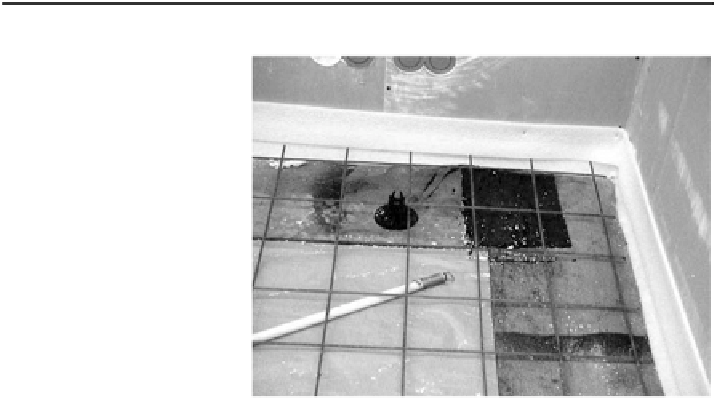Civil Engineering Reference
In-Depth Information
Table 3 Median indoor radon concentration and percentage of houses with indoor radon con-
centration exceeding 200 and 400 Bq/m
3
, for different preventive measures (Arvela
2001
)
Preventive measure
Number
Median
(Bq/m
3
)
Percentage
exceeding
(200 Bq/m
3
)
Percentage
exceeding
(400 Bq/m
3
)
Sealing of leakages in substructure,
slab-on-grade
31
138
32
10
Slab-on-grade, sealing work, sub-slab
piping, no fan
58
155
34
10
Slab-on-grade, sub-slab piping, no fan
141
220
55
26
Slab-on-grade, sub-slab piping, fan
operating
21
55
19
10
Crawl space
20
70
10
5
Edge-thickened slab
4
66
0
0
Fig. 3 Bitumen felt installed
to the joint of foundation wall
and floor slab before casting
of the floor (Arvela et al.
2005
)
Radon averages decrease as the distance from soil increases (Trevisi et al.
2012a
), meaning that a simple protection measure could encompass a reduction in
the time spent by occupants in the areas closer to the ground. For houses with two
or more floors, the rooms must not be located near the ground. Since radon
concentration is very dependent on the air change rate (ACH) (Fig.
5
), it is
important to maintain adequate air ventilation. Of course this means an increase in
heating costs. The option for an increase in the ventilation rate must be assessed by
a cost-effectiveness analysis. This will be addressed in
Sect. 4
.
It is also important to maintain a range of temperature and relative humidity
that minimized radon levels. A recent investigation (Akbari et al.
2013
) showed
that for a detached one-floor house, the minimum radon levels were obtained at
temperatures between 20 and 22 C (Fig.
6
) and a relative humidity of 50-60 %
(Fig.
7
).
According to those authors in high indoor temperatures, diffusion mechanism
increases and boosts the effect of convection mechanism in radon transport

